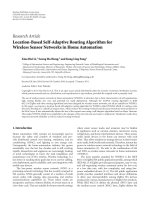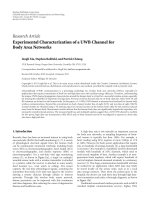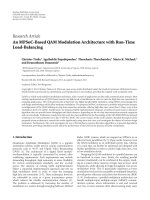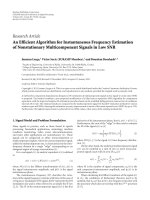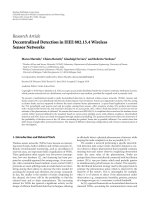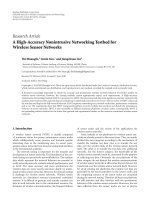Báo cáo hóa học: " Research Article An Energy-Efficient Adaptive Modulation Suitable for Wireless Sensor Networks with SER and Throughput Constraints" ppt
Bạn đang xem bản rút gọn của tài liệu. Xem và tải ngay bản đầy đủ của tài liệu tại đây (605.81 KB, 7 trang )
Hindawi Publishing Corporation
EURASIP Journal on Wireless Communications and Networking
Volume 2007, Article ID 41401, 7 pages
doi:10.1155/2007/41401
Research Article
An Energy-Efficient Adaptive Modulation Suitable for Wireless
Sensor Networks with SER and Throughput Constraints
J. Joaqu
´
ın Escudero Garz
´
as, Carlos Bouso
˜
no Calz
´
on, and Ana Garc
´
ıa Armada
Department of Signal Theory and Communications, University Carlos III of Madrid, Avda de la Universidad 30,
28911 Legan
´
es,Madrid,Spain
Received 16 October 2006; Revised 14 March 2007; Accepted 6 April 2007
Recommended by Mischa Dohler
We consider the problem of minimizing transmission energy in wireless sensor networks by taking into account that every sensor
may require a different bit rate and reliability according to its particular application. We propose a cross-layer approach to tackle
such a minimization in centralized networks for the total t ransmission energy consumption of the network: in the physical layer,
for each sensor the sink estimates the channel gain and adaptively selects a modulation scheme; in the MAC layer, each sensor is
correspondingly assigned a number of time slots. The modulation level and the number of allocated time slots for every sensor are
constrained to attain their applications bit rates in a global energy-efficient manner. The signal-to-noise ratio gap approximation
is used in our exposition in order to jointly handle required bit rates, transmission energies, and symbol error rates.
Copyright © 2007 J. Joaqu
´
ın Escudero Garz
´
as et al. This is an open access article distributed under the Creative Commons
Attribution License, which permits unrestricted use, distribution, and reproduction in any medium, provided the original work is
properly cited.
1. INTRODUCTION
Wireless sensor networks are susceptible to many different
applications in diverse fields such as areas of industry and
commerce (i.e., environment monitoring and control), home
automation and intelligent buildings (i.e., security, lighting,
air conditioning), PC peripherals (i.e., mouse, printer), con-
sumer electronics, medicine and personal health care (i.e.,
monitors, diagnostics, medical body sensors), and surveil-
lance and maintenance among others [1–6]. Furthermore,
the availability of commercial products has fostered poten-
tial applications; examples are given in [7–11]. Particularly,
wireless devices conforming to IEEE 802.15.4 standard and
ZigBee specifications seem to be g aining market due to their
characteristics of low power, low cost, and low rate. These
features make them very well-suited as well for most WSN
applications in the so-called personal area networks (PAN).
Some relevant parameters are usually considered in the
context of PANs such as the type and quality of service, scal-
ability, maintainability, and, specially, lifetime of batteries.
Therefore, energy-efficient communication schemes have be-
come a main challenge in the design of these networks. One
straight approach towards energy efficiency would be the use
of long transmission time intervals, however many applica-
tions impose hard delay contraints. This energy -efficiency
delay tradeoff has been recently studied in [12]. An other
different appproach [13] examines single-hop sensor com-
munications using time division multiple access (TDMA),
proposing optimal and suboptimal algorithms to minimize
the energy to transmit data with a given capacity in the ad-
equate time. Theoretical energy gains are thus obtained for
optimal and suboptimal schemes as compared to the TDMA
ideal capacity. Other approaches for multihop networks have
been developed in [14, 15].
As for centralized WSN, there exist different works fo-
cused on single layer design to tackle the energy minimiza-
tion problem. Examples of PHY-oriented approaches are
given in [16, 17]. Similarly, energy minimization can be ac-
complished through MAC layer protocols as in [12, 13, 15,
18, 19]. Cross-layer design has been typically focused on
MAC and routing layers but does not touch upon the PHY
layer [20–23]. Nevertheless, we consider that PHY layer is of
paramount importance as to cross layer design when energy
efficiency is the aim to tackle. Some recent works on multi-
hop networks follow this same line by using power manage-
ment [24] or coding [25].
Along with energy-efficient transmission, the reliabil-
ity of low-power wireless channels is also a challenge in
WSN, specially in the heterogeneous case when the require-
ments for each sensor may be different according to their
2 EURASIP Journal on Wireless Communications and Networking
implemented services and applications. We will deal with two
essential aspects related to reliability in real wireless chan-
nels for WSN: path loss and symbol error rate. In this pa-
per, to face the aforementioned problems, we propose a prac-
tical and energy-efficient adaptive scheme using cross layer
design. It works as follows: firstly, we estimate the channel
gains between every node and the sink; then, this informa-
tion is used by MAC layer to design the time slots lengths in
an energy-efficient manner; finally, joint consideration of the
calculated time slots lengths and the bit rates determines the
suitable modulation level for the PHY layer.
Due to its high energy efficiency, we have selected multi-
level quadrature amplitude modulation (MQAM). The mod-
ulation level will be adapted to fulfill transmission require-
ments for each sensor by means of SNR gap approximation.
We apply this approximation because it allows to relate a con-
stant application quality (SER) with a constant throughput
straightforwardly. In order to show the performance of the
proposed scheme, the energy needed for our adaptive mod-
ulation scheme will be compared to that of the fixed-slot
TDMA scheme within a PA N environment.
IEEE 802.15.4 MAC protocol [26] provides a mode of op-
eration for sensors requiring service guarantees, making use
of “guaranteed time slots” (GTS) and slotted CDMA. How-
ever, such guaranteed service requests may be rejected by the
PAN coordinator, so these guarantees are not assured. Even
though GTSs are accepted for a certain sensor, energy min-
imization could only be implemented by means of power
transmission control whilst no power management is con-
sidered in the standard. With the TDMA variable-time-slot-
length scheme we propose, optimal energy consumption is
achieved simply by adjusting the time slots durations, keep-
ing the transmitted power constant.
Since the range of modulation levels in practice is mod-
erate, adaptive schemes can be implemented in a straightfor-
ward manner through a parallel hardware architecture. Yet,
another recent alternative for adaptive modulation is soft-
ware radio: its use in the WSN sink can be adopted very easily
and, although its implementation in sensors may not seem so
immediate, some proposals have already been given in this
area [27].
The remaining of the paper is organized as follows.
Section 2 reviews SNR gap approximation. In Section 3,we
formulate the problem and the system description for the
WSN scenario. In Section 4, we present the proposed energy-
efficient adaptive modulation scheme while simulations, and
results are shown in Section 5. Finally, some conclusions are
outlined in Section 6.
2. REVIEW OF SNR GAP APPROXIMATION
SNR gap approximation provides a simple way to relate SNR
(signal-to-noise-ratio), bit rate R
b
and SER (symbol error
Rate) for a given modulation (e.g., M-QAM) and coding
scheme [28]. It has been generally used for bit-loading pur-
poses because it makes algorithms easier to implement [29].
Different multilevel modulations can be used for adap-
tive modulation. M-QAM provides a lower probability sym-
bol error compared to M-PSK for the same SNR. M-FSK is a
priori more energy-efficient compared to M-QAM; however,
the bandwidth efficiency (bps/Hz) can be a drawback, up to
8 times less than M-QAM (M
= 16) [30], resulting then that
we would need 8 times more bandwidth. As our system is
narrowband and, in addition, the bandwidth is constant, our
interest falls on an efficient-bandwidth modulation, so M-
QAM is more adequate. Additionally, if we consider the dis-
tance of the link, energy can be optimized using M-QAM and
M-FSK [17]; the energy per bit is lower for M-QAM for dis-
tance less than 30 m, which is our range of interest. Other re-
lated works consider also M-QAM as the multilevel modula-
tion to be used for energy efficient communications [31, 32].
Then, in this paper we will use M-QAM modulation
because of its higher-energy efficiency for centralized WSN
with PAN coverage. If M-QAM modulation is used, SNR gap
approximation states that the number of bits per symbol Λ
may be found as
Λ
= log
2
1+
γ
Γ
=
log
2
M,
Γ
=
1
3
Q
−1
SER
4
2
,
Q(x)
=
∞
x
e
−u
2
/2
√
2π
du,
(1)
where γ is the SNR, that is, γ
= E
S
/N
0
,requiredtoconveyΛ
bits per symbol achieving a given error probability SER in a
flat-frequency propagation channel corrupted by AWGN, Γ
is the SNR gap [33]andQ(x) is also defined in [33]. In prac-
tical applications, Λ and M take real values but have to be
discretized. We will use ΔM as the increment between con-
secutive allowed values of M and we will examine the pro-
posed scheme performance depending on this value.
In real applications, however, the usual way to specify the
data-rate is in bits per second (bps), so for our convenience
we will use R in these units considering a symbol period T
S
:
R
=
1
T
S
log
2
1+
γ
Γ
=
1
T
S
Λ. (2)
3. PROBLEM FORMULATION AND
SYSTEM DESCRIPTION
3.1. Problem formulation
Let us consider a centralized WSN where a central node or
sink needs to collect information from N sensors. Each of
these sensors potentially could be implementing a different
application or service, resulting in different data-rates R
n
and
symbol error rates SER
n
for each one, where subindex “n”is
used to denote different users. Let us assume a total frame
duration T, and a time interval of variable length T
n
is as-
signed to sensor n; consequently, the sum of all time intervals
equals T:
N
n=1
T
n
= T. (3)
J. Joaqu
´
ın Escudero Garz
´
as et al. 3
For energy minimization purposes, we will calculate the en-
ergy E
n
associated to nth sensor as the energy used for the
transmission in the corresponding nth time slot:
E
n
= E
Stx
·
T
n
T
S
. (4)
We will base then our analysis of energy on the trans-
mitted symbol energy E
Stx
and the relation T
n
/T
S
, which de-
termines the number of symbols transmitted during the nth
time slot N
n
: N
n
= T
n
/T
S
. This energy model is a simplified
one, since total energy consumption in the sensor encom-
passes also active-sleep transitions power and circuit power
consumption [17, 31];then,afullyrealisticmodelwouldtake
them into account.
It is clear that some entity in the network must coordi-
nate the time assignments, that is, the time-slots duration
T
n
, and estimate the channel parameters we will need for
the adaptive modulation scheme (see Section 3.2). Therefore,
some signaling system must be implemented in order to in-
form the sensors about these assignments. Since the network
topology is centralized, these tasks (included channel estima-
tion) are assumed by the sink, because sensors are intended
to be as simple as possible and may have limitations in pro-
cessing; the feedback information can be implemented with-
out significant trafficload[34].
In this paper, the function to be minimized is the sum
of individual energies needed by each sensor per time inter-
val given by (4); R
n
and SER
n
will be guaranteed for each
sensor despite changes in SNR
n
due to channel variations by
adapting the modulation and the transmission time. Then,
the problem to solve can be for mulated as the follow ing con-
strained minimization problem:
minimize
N
n=1
E
n
=
N
n=1
E
Stx
·
T
n
T
S
subject to
N
n=1
T
n
= T.
(5)
3.2. System description
Our system model is a centralized wireless sensor network
(Figure 1) made up of sensors whose transmission require-
ments may differ with respect to each other in bit rate and
quality of service, since the implemented applications may
be different.
We state our problem from the receiver point of view, so
a loss model must be defined to estimate the received energy.
The reason for this is that SER is a key para meter in the pro-
posed energy-efficient adaptive modulation scheme and we
will formulate it as a function of the received symbol energy
(see Section 4). Then, if the energy transmitted by each sen-
sor can be calculated as E
n
= P
n
· T
n
, being P
n
the nominal
transmission power of the device, a path loss needs to be in-
cluded to estimate the received power. The average path loss
PL
n
can be calculated according to the propagation model
described in [35], where distance from each transmitter to
h
1
h
N
h
3
h
2
Sensor 1
Sensor N
Sensor 3
Sensor 2
Sink
Figure 1: Wireless sensor network scheme: a centralized configura-
tion.
the receiver (d
n
) is in the order of personal communications
range (up to 10 m):
PL
n
= S
0
+10a logd
n
+ b (dB) (6)
being in the previous expression S
0
the path loss at 1 m dis-
tance, a and b correspond to parameters for LOS (line of
sight) scenario in the ISM band (2.4 GHz) in indoor envi-
ronment. The height of antennas is assumed to be 1 m for
the receiver and between 1–3 m for the transmitters.
In addition to path loss, a Rayleigh distribution has
been used in order to model small-scale fading for each
transceiver. This fading will be represented by the coefficients
h
n
.
The consideration of both loss factors (path loss and
small-scale fading) leads to a modification of the optimiza-
tion problem (5). The received energy per symbol can be cal-
culated then as E
Srx
= E
Stx
/(α
n
·|h
n
|
2
), where E
Stx
denotes
the transmitted energy per symbol and α
n
= 10
PL
n
/10
;refor-
mulating (5):
minimize
N
n=1
E
n
=
N
n=1
E
Srx
·
T
n
T
s
·
h
n
2
α
n
subject to
N
n=1
T
n
= T.
(7)
4. ADAPTIVE MODULATION WITH SER
AND THROUGHPUT CONSTRAINTS
As has been mentioned in the previous sections, the design
of the time slots length is performed using SNR gap approxi-
mation as a means to relate the qualit y of service parameters
we wish to guarantee (SER and bit rate). In contrast to fixed
TDMA, in which all time intervals have the same duration,
with the energy-efficient scheme, the length of time intervals
T
n
will be a function of the required bit rate R
n
and the SER
n
.
The differencebetweentransmissionframescanbeseenin
Figure 2. In this fashion, the defined energy-efficient adaptive
modulation scheme ensures fairness: although nodes seem to
4 EURASIP Journal on Wireless Communications and Networking
T/N T/N
···
T/N
T
Fixed time slot length TDMA frame
T
1
T
2
··· T
N
T
Variable time slot length TDMA frame
Figure 2: Fixed and variable time-slots length TDMA frames.
be “stealing” time for transmission each other, every node is
maintaining the required quality specified by R
n
and SER
n
.
The nth sensor bit rate R
n
is calculated using (2):
R
n
=
N
n
T
log
2
M =
N
n
T
log
2
1+
γ
Γ
. (8)
Analyzing (8), we observe that required R
n
is assured per-
forming adaptive modulation: we assume invariant propaga-
tion channel during frame T, and if channel conditions get
worse from frame to frame, the SNR
n
decreasesaswellasthe
number of bits per symbol given by log
2
(1 + γ/Γ). In order to
keep R
n
constant, the transmission interval must increase via
N
n
.
Recalling that γ
= E
Srx
/N
0
, the required energy per user
to be minimized of (7) c an be expressed as:
E
n
= E
Srx
·
T
n
T
s
·
h
n
2
α
n
= γ · N
0
· N
n
·
h
n
2
α
n
= Γ · N
0
· N
n
·
h
n
2
α
n
2
Rn·T/Nn
− 1
.
(9)
Without loss of generality, E
n
has been normalized with re-
spect to N
0
. Written formally, we need to solve the following
constrained optimization problem:
minimize
N
n=1
E
n
=
N
n=1
Γ · N
n
·
h
n
2
α
n
2
R
n
·T/N
n
− 1
subject to
N
n=1
T
n
= T.
(10)
The solution to (10) can be founded using Lagrangean’s mul-
tipliers method, and the set of
{N
n
}
N
n
=1
which optimize the
total energy must satisfy
λ
= Γ ·
h
n
2
α
n
1+2
Rn·T/Nn
R
n
N
n
ln 2 − 1
, (11)
where Lagrangean multiplier λ can be obtained by numerical
search. It is straightforward to calculate the time duration of
each interval as T
n
= T
S
· N
n
.
Furthermore, the corresponding E
n
will decrease accord-
ing to (9), as can be expected since the level of the M-QAM
modulation will decrease (M
= 1+γ/Γ) but to preserve the
bit rate, the transmission time must increase.
5. SIMULATION SETUP AND RESULTS
The system described has been simulated taking as a ref-
erence IEEE 802.15.4 standard in order to make a realis-
tic choice of the simulation parameter values. The band
2.4
2.2
2
1.8
1.6
1.4
1.2
1
Energy gain (dB)
14000120001000080006000400020000
R
n
deviation (bps)
Vari able T DMA, M
= 16
Fixed TDMA, M
= 16
Figure 3: Energy gain with respect to fixed TDMA and variable
length TDMA with 16-QAM modulation, N
= 896 symbol periods.
for transmission is the ISM band (2.4 GHz), defined as the
primary band for this ty pe of networks. The bandwidth is
62.5 KHz, and the symbol period equals the 802.15.4 sym-
bol period T
S
= 16 μs. In order to consider the channel
invariant during a frame transmission, coherence time T
c
must be larger than the duration of the frame, and T
c
can
be calculated as [36] T
c
= 0.423/f
m
, being f
m
= v · f
c
/c,
c
= 300000 m/s, v = 3 Km/h (walking velocity), and f
c
the carrier frequency 2.4 GHz; then T
c
= 63.45 ms. The
frame length has been chosen considering that 802.15.4 states
a length from 15 milliseconds to 250 seconds; according to
the value obtained for T
c
, we have chosen a duration frame
about 15 mil liseconds, corresponding to 896 symbols of 16 μs
(14.336 ms). The rest of parameters have the following val-
ues: the total bit rate of the network is 250 Kbps and SER
=
10
−3
.
The energy gain (defined as the ratio of the required
energy in each case), when using energy-efficient adaptive
modulation compared to conventional TDMA allocation, is
the parameter used to compute saving in energy. We dis-
tinguish two cases: (a) fixed TDMA with fixed modulation
16-QAM for each sensor and (b) variable length TDMA
with fixed modulation (M
= 16 and 64), which are shown
in Figures 3 and 4, and a frame of 896 symbols is consid-
ered (802.15.4); abscissa axis represents the deviation among
the different 16 sensors bit rates, to account for the hetero-
geneous nature of the network. Distance between sensors
and sink is a random uniformly distributed variable with
value in the range 1–10 m. Note that gains up to near 6 dB
are obtained, and the heterogeneousness of the network do
not have an important influence on the gain, so the per-
formance of the adaptive scheme is able to tackle this situ-
ation without degradation. We have considered also inter-
esting to select the parameters for another typical wireless
J. Joaqu
´
ın Escudero Garz
´
as et al. 5
5.85
5.8
5.75
5.7
5.65
5.6
Energy gain (dB)
14000120001000080006000400020000
R
n
deviation (bps)
Vari able T DMA, M
= 64
Figure 4: Energy gain with respect to variable length TDMA with
64-QAM modulation, N
= 896 symbol periods.
2.4
2.2
2
1.8
1.6
1.4
1.2
1
Energy gain (dB)
14000120001000080006000400020000
R
n
deviation (bps)
Vari able T DMA, M
= 16
Fixed TDMA, M
= 16
Figure 5: Energy gain with respect to fixed TDMA and variable
length TDMA with 16-QAM modulation, N
= 64 symbol periods.
sensors environment, as Bluetooth; in this c ase, the possibil-
ities for duration frame are. 0.625/1.875/3.125 milliseconds,
so we have selected a frame of 64 symbols, corresponding to
1.024 millisecond. Figures 5 and 6 shows the energy gain in
the mentioned (a) and (b) situations with the new parame-
ters.
The effect of correlation among the propagation small-
scale (Rayleigh) channels sensor-sink h
n
, is taken into ac-
count. Parameter σ indicates the correlation among chan-
nels. The energy gain is shown in Table 1 for frame duration
N
= 896 symbols, and it could be expected a significant dif-
5.61
5.6
5.59
5.58
5.57
5.56
5.55
Energy gain (dB)
14000120001000080006000400020000
R
n
deviation (bps)
Figure 6: Energy gain with respect to variable length TDMA with
64-QAM modulation, N
= 64 symbol periods.
Table 1: Energy gain for energy-efficient adaptive modulation com-
pared to conventional TDMA with different correlations between
channels (σ
2
), N = 896 symbols.
M Deviation (Kbps) σ
2
G fixed (dB) G variable (dB)
16 0 1 1,15 1,02
16
0 20 1,24 1,06
16
5.8 1 1,44 1,07
16
5.8 20 1,34 1,07
16
13 1 2,11 1,19
16
13 20 2,12 1,23
64
01— 5,6
64
0 20 — 5,62
64
5.8 1 — 5,68
64
5.8 20 — 5,7
64
13 1 — 5,81
64
13 20 — 5,93
ference favourable to the uncorrelated case that in practice
does not occur. The explanation to this is that the path loss
coefficients (α
n
) are much larger than the Rayleigh fading co-
efficients (h
n
) and, as can be observed in (9), the optimized
energy E
n
is strongly dominated by path loss effect. Related to
this, sensors in the lowest distance (d
= 1m)useaverylow
number of time slots (3, 4, 5 symbols per time slot), and con-
sequently the level of modulation M is high. Similar results
and conclusions apply for the case of N
= 64 symbols.
In simulations, discrete bit-loading has been addressed
in order to preserve practicality; we have used ΔM
= 1en-
suring always a bit rate higher than the searched R
n
, taking
into account that any integer value of M can be achieved us-
ing an appropriate coding. Additionally, we have explored the
energy consumption of the uncoded case with the restric tion
M
= 2
k
(being k an integer) with respect to ΔM = 1, and we
found that the former choice implies an increment in energy
that can be up to 7 dB for high-level modulations.
6 EURASIP Journal on Wireless Communications and Networking
It is important to consider power limitations that are gen-
erally and worldwide imposed by regulating agencies to ra-
diofrequency transmissions. In IEEE 802.15.4 applications,
the maximum allowed transmit power is 100 mW, but in
practical 802.15.4 networks usual values of about 1 mW
are very common. In the simulations carried out using the
proposed energy-efficient scheme, the needed power was
checked to be below this practical limit value. The result
is that the maximum transmit power obtained is slightly
larger than 1 mW and usual values are a few hundreds of mi-
crowatts.
6. CONCLUSIONS
Energy efficiency is critical to lifetime and performance of
wireless sensor networks. In this work, we have developed
an energy-efficient cross layer adaptive modulation scheme
that minimizes the total energy utilized by the network. This
scheme is based on bit rate and reliability: SER is main-
tained for the required bit rate of the implemented applica-
tion adapting the M-QAM modulation. As a consequence,
the design of WSN can be realized assuring the quality of ser-
vice for the different implemented applications.
It must be noted that although we have chosen M-QAM
as the modulation scheme, M-PSK modulation can be a pos-
sibility to be considered [37].ThechoiceofM-QAM has
been made because of its higher-energy efficiency, since this
is the parameter we are focusing our interest on. Neverthe-
less, M-PSK may be useful for other reasons: it can offer
advantages in some other situations due to its behavior in
terms of Peak-to-average power ratio (PAR); this possibilit y
remains to be explored.
Another important topic to consider is mobility in this
type of networks: the channel model we have considered as-
sumes that sensors are static (or restricted to very slow move-
ment). Our system model and the energy-efficient scheme
developed in this paper may be suitable for the case of mo-
bile sensors. However, the gain in this case should be eval-
uated with the inclusion of an appropriate channel model;
this scenario could be of great interest for a wide range of
different applications, such as mobile body sensors, mobile
home personal devices, image transmission in surveillance
systems, and mobile security sensors, always considering not
high speeds.
ACKNOWLEDGMENTS
The authors wish to thank the anonymous reviewers for
their ver y helpful suggestions and comments. This work
has been partially funded by CRUISE NoE (IST-4-027738),
MAMBO2 (CCG06-UC3M/TIC-0698) and MACAWI (TEC-
2005-07477-C02-02) projects.
REFERENCES
[1] C.Sharp,S.Schaffert, A. Woo, et al., “Design and implemen-
tation of a sensor network system for vehicle tracking and au-
tonomous interception,” in Proceedings of the 2nd European
Workshop on Wireless Sensor Networks (EWSN ’05), pp. 93–
107, Istanbul, Turkey, January-February 2005.
[2] G. Werner-Allen, J. Johnson, M. Ruiz, J. Lees, and M. Welsh,
“Monitoring volcanic eruptions with a wireless sensor net-
work,” in Proceedings of the 2nd European Workshop on Wireless
Sensor Networks (EWSN ’05), pp. 108–120, Istanbul, Turkey,
January-February 2005.
[3] M. M. Nordman and M. Lehtonen, “A wireless sensor con-
cept for managing electrical distribution networks,” in Pro-
ceedings of IEEE PES Power Systems Conference and Exposition
(PSCE ’04), vol. 2, pp. 1198–1206, New York, NY, USA, Octo-
ber 2004.
[4] H. Bai, M. Atiquzzaman, and D. Lilja, “Wireless sensor
network for aircraft health monitoring,” in Proceedings of
the 1st International Conference on Broadband Networks
(BroadNets ’04), pp. 748–750, San Jose, Calif, USA, October
2004.
[5] Y. Li, S. S. Panwar, and S. Burugupalli, “A mobile sensor net-
work using autonomously controlled animals,” in Proceed-
ings of the 1st International Conference on Broadband Networks
(BroadNets ’04), pp. 742–744, San Jose, Calif, USA, October
2004.
[6] V. Rajaravivarma, Y. Yi, and Y. Teng, “An overview of wireless
sensor network and applications,” in Proceedings of the 35th
Southeastern Symposium on System Theory, pp. 432–436, Mor-
gantown, WVa, USA, March 2003.
[7] L J. Hwang, S T. Sheu, Y Y. Shih, and Y C. Cheng, “Group-
ing strategy for solving hidden node problem in IEEE 802.15.4
LR-WPAN,” in Proceedings of the 1st International Conference
on Wireless Internet (WICON ’05), pp. 26–32, Budapest, Hun-
gary, July 2005.
[8] G. Pekhteryev, Z. Sahinoglu, P. Orlik, and G. Bhatti, “Im-
age transmission over IEEE 802.15.4 and ZigBee networks,” in
Proceedings of IEEE International Symposium on Circuits and
Systems (ISCAS ’05), vol. 4, pp. 3539–3542, Kobe, Japan, May
2005.
[9] J. A. Gutierrez and D. B. Durocher, “On the use of IEEE
802.15.4 to enable wireless sensor networks in pulp and pa-
per industrys,” in Proceedings of Annual Pulp and Paper Indus-
try Technical Conference, pp. 105–110, Jacksonville, Fla, USA,
June 2005.
[10] S. Hara, D. Zhao, K. Yanagihara, et al., “Propagation charac-
teristics of IEEE 802.15.4 radio signal and their application for
location estimation,” in Proceedings of the 61st IEEE Vehicu-
lar Technology Conference (VTC ’05), vol. 1, pp. 97–101, Stock-
holm, Sweden, May-June 2005.
[11] N. F. Timmons and W. G. Scanlon, “Analysis of the perfor-
mance of IEEE 802.15.4 for medical sensor body area network-
ing,” in Proceedings of the 1st Annual IEEE Communications So-
ciety Conference on Sensor and Ad Hoc Communications and
Networks (SECON ’04) , pp. 16–24, Santa Clara, Calif, USA,
October 2004.
[12] Y. Yu, B. Krishnamachari, and V. K. Prasanna, “Energy-latency
tradeoffs for data gathering in wireless sensor networks,” in
Proceedings the 23rd Annual Joint Conference of the IEEE Com-
puter and Communications Societies (INFOCOM ’04), vol. 1,
pp. 244–255, Hong kong, March 2004.
[13] Y. Yao and G. B. Giannakis, “Energy-efficient scheduling for
wireless sensor networks,” IEEE Transactions on Communica-
tions, vol. 53, no. 8, pp. 1333–1342, 2005.
[14] J. Haapola, Z. Shelby, C. Pomalaza-Raez, and P. Maho-
nen, “Cross-layer energy analysis of multihop wireless sensor
J. Joaqu
´
ın Escudero Garz
´
as et al. 7
networks,” in Proceeedings of the 2nd European Workshop on
Wireless Sensor Networks (EWSN ’05), pp. 33–44, Istanbul,
Turkey, January-Feburary 2005.
[15] Z. Shelby, C. Pomalaza-Raez, and J. Haapola, “Energy op-
timization in multihop wireless embedded and sensor net-
works,” in Proceedings of the 15th IEEE International Sympo-
sium on Personal, Indoor and Mobile Radio Communications
(PIMRC ’04), vol. 1, pp. 221–225, Barcelona, Spain, Septem-
ber 2004.
[16] S. Cui, A. J. Goldsmith, and A. Bahai, “Energy-efficiency of
MIMO and cooperative MIMO techniques in sensor net-
works,” IEEE Journal on Selected Areas in Communications,
vol. 22, no. 6, pp. 1089–1098, 2004.
[17] S. Cui, A. J. Goldsmith, and A. Bahai, “Energy-constrained
modulation optimization,” IEEE Transactions on Wireless
Communications, vol. 4, no. 5, pp. 2349–2360, 2005.
[18] R. Jurdak, P. Baldi, and C. V. Lopes, “State-driven energy op-
timization in wireless sensor networks,” in Proceedings of IEEE
Systems Communications (ICW ’05), pp. 356–363, Montreal,
Canada, August 2005.
[19] S. C. Evans, N. Van Stralen, J. Hershey, and H. Tomlinson,
“Energy minimization in wireless sensor networks through an
adaptive connectionless scheduling protocol (adaptive CSP),”
in Proceedings of IEEE Military Communications Conference
(MILCOM ’05), vol. 5, pp. 2990–2996, Atlatnic City, NJ, USA,
October 2005.
[20] C F. Chou and K T. Chuang, “CoLaNet: a cross-layer design
of energy-efficient wireless sensor networks,” in Proceedings of
IEEE Systems Communications (ICW ’05), pp. 364–369, Mon-
treal, Canada, August 2005.
[21] Q. Liang, “Fault-tolerant and energy efficient wireless sensor
networks: a cross-layer approach,” in Proceedings of IEEE Mil-
itary Communications Conference (MILCOM ’05), vol. 3, pp.
1862–1868, Atlatnic City, NJ, USA, October 2005.
[22] X. Lu, Y. Sun, J. Yu, and W. Yan, “An energy efficient cross-layer
routing algorithm for wireless sensor networks,” in Proceedings
of the 1st IEEE Conference on Industrial Electronics and Appli-
cations (ICIEA ’06), pp. 1–5, Singapore, May 2006.
[23] I Y. Kong and W J. Hwang, “Lifetime maximization by cross-
layer interaction in wireless sensor networks,” in Pro ceedings
of the 8th International Conference Advanced Communication
Technology (ICACT ’06), vol. 3, pp. 2055–2060, Phoenix Park,
Korea, February 2006.
[24]H.Kwon,T.H.Kim,S.Choi,andB.G.Lee,“Across-layer
strategy for energy-efficient reliable delivery in wireless sen-
sor networks,” IEEE Transactions on Wireless Communications,
vol. 5, no. 12, pp. 3689–3699, 2006.
[25] H. Karvonen and C. Pomalaza-Raez, “A cross layer design
of coding and awake/sleep periods in WSNS,” in Proceedings
of the 17th IEEE International Symposium on Personal, In-
door and Mobile Radio Communications (PIMRC ’06), pp. 1–5,
Helsinki, Finland, September 2006.
[26] IEEE Std 802.15.4-2003, IEEE Standard for Information
technology—telecommunications and information exchange
between systems—local and metropolitan area networks—
specific requirements—part 15.4: Wireless LAN Medium Ac-
cess Control (MAC) and Physical Layer (PHY) Specifications
for Low-Rate Wireless Personal Area Networks (LR-WPANS).
[27] J. Shen, X. Yuan, L. Shen, D. Yao, and H. Liu, “An energy-
efficient node for wireless sensor networks using software ra-
dio,” in Proceedings of the 6th IEEE International Conference
on Electro/Information Technology (EIT ’06), pp. 245–249, East
Lansing, Mich, USA, May 2006.
[28] J. M. Cioffi,G.P.Dudevoir,M.V.Eyuboglu,andG.D.Forney
Jr., “MMSE decision-feedback equalizers and coding—part II:
coding results,”
IEEE Transactions on Communications, vol. 43,
no. 10, pp. 2595–2604, 1995.
[29] A. G. Armada, “A simple multiuser bit loading algorithm for
multicarrier WLAN,” in Proceedings of IEEE International Con-
ference on Communications (ICC ’01), vol. 4, pp. 1168–1171,
Helsinki, Finland, June 2001.
[30] A. Y. Wang, S H. Cho, C. G. Sodini, and A. P. Chandrakasan,
“Energy efficient modulation and MAC for asymmetric RF
microsensor systems,” in Proceedings of the International Sym-
posium on Low Power Electronics and Design (ISLPED ’01),pp.
106–111, Huntington Beach, Calif, USA, August 2001.
[31] E. Shih, S H. Cho, N. Ickes, e t al., “Physical layer driven
protocol and algorithm design for energy-efficient wireless
sensor networks,” in Proceedings of the 7th Annual Inter-
national Conference on Mobile Computing and Networking
(MOBICOM ’01), pp. 272–287, Rome, Italy, July 2001.
[32] C. Schurgers, O. Aberthorne, and M. B. Srivastava, “Mod-
ulation scaling for energy aware communication systems,”
in Proceedings of the International Symposium on Low Power
Electronics and Design (ISLPED ’01), pp. 96–99, Huntington
Beach, Calif, USA, August 2001.
[33] T. Starr, J. M. Cioffi, and P. J. Silverman, Understanding Digital
Subscriber Line Technology, Prentice Hall PTR, Upper Saddle
River, NJ, USA, 1999.
[34] M. Johansson, “Diversity-enhanced equal access-considerable
throughput gains with 1-bit feedback,” in Proceedings of the
5th IEEE Workshop on Signal Processing Advances in Wire-
less Communications (SPAWC ’04), pp. 6–10, Lisbon, Portugal,
July 2004.
[35] G. J. M. Janssen, P. A. Stitger, and R. Prasad, “Wideband in-
door channel measurements and BER analysis of frecuency se-
lective multipath channels at 2.4, 4.75 and 11.5 GHz,” IEEE
Transactions on Communications, vol. 44, no. 10, pp. 1272–
1288, 1996.
[36] T. S. Rappaport, Wireless Communications: Principles and Prac-
tice, Prentice Hall PTR, Upper Saddle River, NJ, USA, 2nd edi-
tion, 2002.
[37] A. G. Armada, “SNR gap approximation for M-PSK-based
bit loading,” IEEE Transactions on Wireless Communications,
vol. 5, no. 1, pp. 57–60, 2006.

